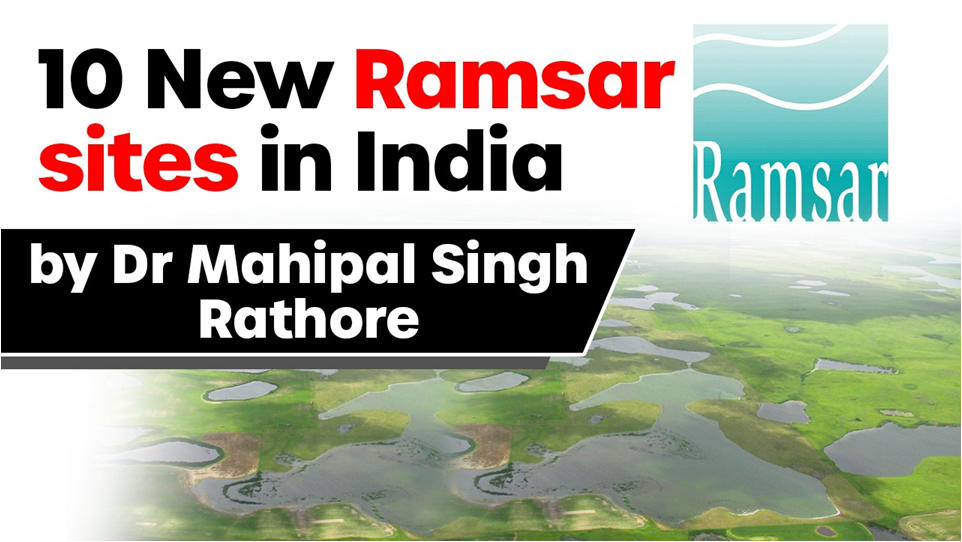Table of Contents

The news
- Union Minister for Environment, Forests and Climate Change, Prakash Javadekar recently announced that the Ramsar Convention has declared 10 more wetlands from India as sites of “international importance”, taking the total number of Ramsar sites in India to 37.
- These sites have been added to The list of Ramsar sites – The list comprises wetlands deemed to be of “international importance” under the Ramsar Convention.

The Ramsar convention
- The Ramsar Convention is one of the oldest inter-governmental accords signed to preserve the ecological character of wetlands of international importance in the signatory countries.

- The aim of the Ramsar list is to develop and sustain a network of wetlands by maintaining components of their ecosystem and processes.
- The wetlands declared as Ramsar sites are protected under strict guidelines of the convention.
Why are Wetlands important?
- Wetlands provide a wide range of important resources and ecosystem benefits such as food, water, fibre, groundwater recharging, water purification, flood moderation, erosion control and climate regulation.
- They are, in fact, are a major source of water and our main supply of freshwater comes from an array of wetlands which help soak rainfall and recharge groundwater.
Govt Efforts
- In the past six months, the Ministry of Environment, Forest & Climate Change has prepared a four-pronged strategy for the restoration of wetlands which includes
- preparing baseline data,
- wetland health cards,
- enlisting wetland mitras and
- preparing targeted integrated management plans.
- The Ramsar sites
- Globally, there are over 2,300 Ramsar sites around the world covering over 2.1 million sq km.
- India had 27 sites till December 2019.
- With the addition of these ten sites, the total protected wetland area in the country now covers a surface area of 1,067,939 hectares or 10,679 sq km
The new sites
- Nandur Madhameshwar bird sanctuary
- Keshopur-Miani community reserve
- Beas Conservation Reserve
- Nangal wildlife sanctuary
- Nawabganj bird sanctuary
- Parvati Agra bird sanctuary
- Saman bird sanctuary
- Samaspur bird sanctuary
- Sandi bird sanctuary
- Sarsai Nawar Lake
- 1 in Maharashtra (first for the state)
- 3 in Punjab
- 6 in Uttar Pradesh

Maharashtra
- Nandur Madhameshwar bird sanctuary
- Located in Nashik District. It houses a bird sanctuary.
- It is also known as the Bharatpur of Maharashtra.

Punjab
- Keshopur-Miani community reserve
- Gurdaspur
- It lies in the middle of the Ravi and Beas rivers
- It was the first-ever notified community reserve of India, it has the mechanism of joint management of locals and forest department.
- The participatory management has resulted in better conservation
- It has emerged as a favourable home for migratory birds.

Beas Conservation Reserve
- The 185-km stretch of Beas river starting from the Harike headworks to Talwara Conservation Reserve.
- It is widely known for successful reintroduction of Gharials.
Nangal wildlife sanctuary
- Roopnagar district , Near Sutlej river
- Numerous species of resident as well as migratory birds.
- It also houses threatened species like the Indian pangolin.

Uttar Pradesh
- Nawabganj bird sanctuary
- Parvati Aranga bird sanctuary
- Saman bird sanctuary
- Samaspur bird sanctuary
- Sandi bird sanctuary
- Sarsai Nawar Lake
- Nawabganj
- Parvati Aranga
- Saman
- Samaspur
- Sandi
- Sarsai Nawar Lake

Nawabganj bird sanctuary
- Unnao district
- Also known as Chandrashekhar Azad Bird sanctuary
- The sanctuary welcomes many international and national migratory birds.
- Among those are Garganey Teal, Mallard, Purple Moorhen, Little Grebe, Spoonbill Duck, Red Wattled Lapwing, Wigon.
Parvati Aranga bird sanctuary
- Gonda district
- Parvati and Aranga are two rain-fed lakes which are 1.5 km apart.
- It is a potential ecotourism site in terms of providing facilities of bird conservation awareness.
Saman Bird Sanctuary
- Bhogav, Mainpuri district (near Etawah).
- It was notified in 1990 with an objective to protect the large population of Cranes in the area.
- Among the storks it houses include Painted Stork, Block-necked Stork, Open-billed Stork and Woolly-necked Stork.
Samaspur bird sanctuary
- Raebareli district.
- It is known for the preservation of bird species including various migratory birds.
- It houses more than 250 species of birds and remains a favourite bird destination.
- Vulture, Kingfishers, Spot Bill Teel common and Teel Whistling etc. are permanent residents of this sanctuary.
- Sandi bird sanctuary
- Hardoi district.
- Bombay natural history society has listed this sanctuary as an “important bird area”.
Sarsai Nawar Lake
- It is a small unprotected wetland, in Etawah District of Uttar Pradesh.
- It comprises of two small lakes that attract Sarus Cranes, White Ibis and other water birds in large numbers.
- It houses a large population of the threatened species of Sarus Cranes which are the world’s tallest flying birds.
Which Indian sites are part of Montreux Record?
- Montreux Record under the Convention is a register of wetland sites on the List of Wetlands of International Importance where changes in ecological character have occurred, are occurring, or are likely to occur as a result of technological developments, pollution or other human interference.
- It is maintained as part of the Ramsar List.
- Currently, two wetlands of India are in Montreux record:
- Keoladeo National Park (Rajasthan)
- Loktak Lake (Manipur)
Latest Burning Issues | Free PDF






















 WhatsApp
WhatsApp